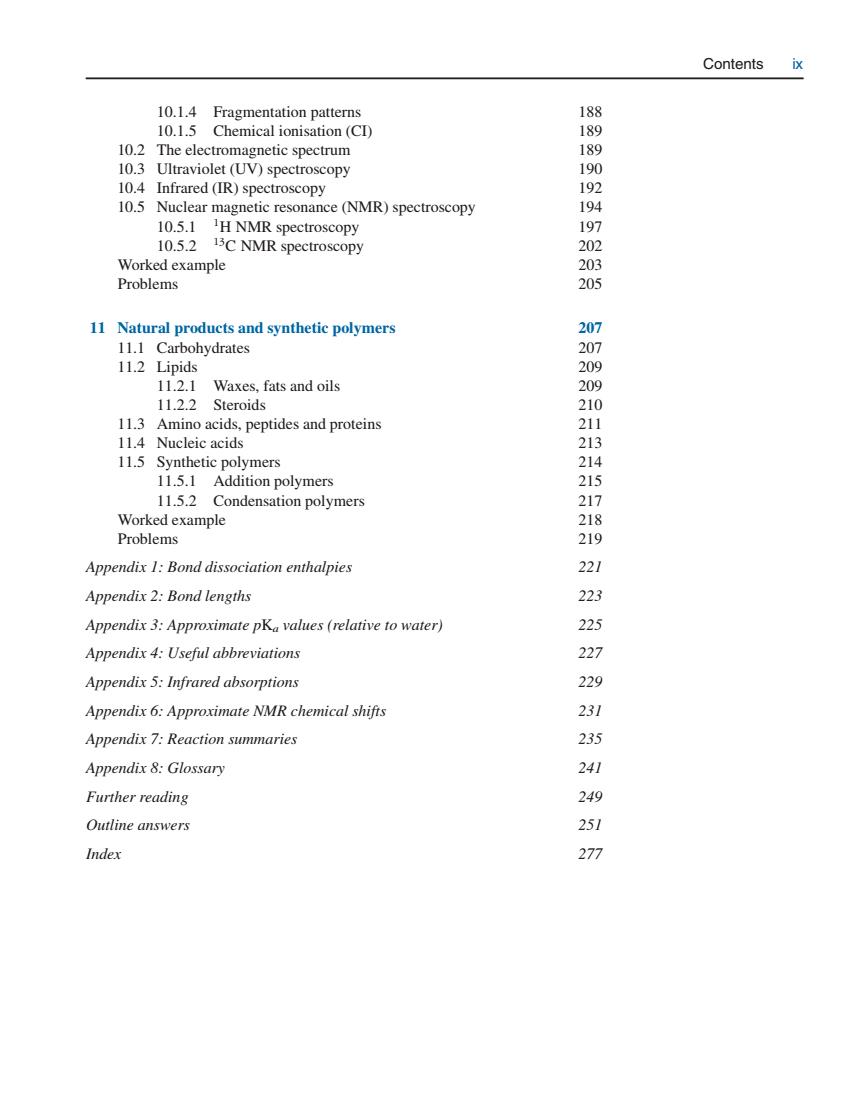正在加载图片...

Contents ix 10.1.4 Fragmentation patterns 10.1.5 Chemical ionisation(CD 10.2 The electromagnetic spectrum 10.3 Ultraviolet(UV)spectroscopy 10.4 Infrared (IR)spec oscopy 10.5 Nuclear magnetic resonance(NMR)spectroscopy 10.5.1 10.5.2 copy Worked example Problems 11 Natural products and synthetic polymers 11.1 Carbohydrates 11.2 Lipids 11.2.1 Waxes,fats and oils 11.2.2 Steroids 00010 11.3 Amino acids.peptides and proteins 1 11.4 Nucleic acids 213 11.5 Synthetic polymers 11.5.1 Addition polymers 11.5.2 Condensation polymers Worked example Problems Appendix 1:Bond dissociation enthalpies Appendix 2:Bond lengths Appendix 3:Approximate pKa values (relative to water) 2 Appendix 4:Useful abbreviations Appendix 5:Infrared absorptions 29 Appendix 6:Approximate NMR chemical shifts Appendix 7:Reaction summaries Appendix 8:Glossary 241 Further reading 2 Outline answer Index10.1.4 Fragmentation patterns 188 10.1.5 Chemical ionisation (CI) 189 10.2 The electromagnetic spectrum 189 10.3 Ultraviolet (UV) spectroscopy 190 10.4 Infrared (IR) spectroscopy 192 10.5 Nuclear magnetic resonance (NMR) spectroscopy 194 10.5.1 1H NMR spectroscopy 197 10.5.2 13C NMR spectroscopy 202 Worked example 203 Problems 205 11 Natural products and synthetic polymers 207 11.1 Carbohydrates 207 11.2 Lipids 209 11.2.1 Waxes, fats and oils 209 11.2.2 Steroids 210 11.3 Amino acids, peptides and proteins 211 11.4 Nucleic acids 213 11.5 Synthetic polymers 214 11.5.1 Addition polymers 215 11.5.2 Condensation polymers 217 Worked example 218 Problems 219 Appendix 1: Bond dissociation enthalpies 221 Appendix 2: Bond lengths 223 Appendix 3: Approximate pKa values (relative to water) 225 Appendix 4: Useful abbreviations 227 Appendix 5: Infrared absorptions 229 Appendix 6: Approximate NMR chemical shifts 231 Appendix 7: Reaction summaries 235 Appendix 8: Glossary 241 Further reading 249 Outline answers 251 Index 277 Contents ix